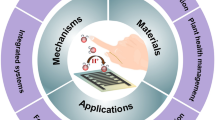Abstract
For the new Flash DSC 1, the temperature windows-to-operate—the temperature ranges where the real, achieved scan rate is constant—have been determined for unloaded sensors under various conditions like purge gas and flow rate variations; cooling to −90 °C and heating to 450 °C; scan rates from 1 up to 20,000 °C s−1 in heating and 15,000 °C s−1 in cooling. Compared to nitrogen, helium purge gas offers better access to low-temperature transitions and enables faster cooling. Drawback is the decreased temperature window-to-operate in heating at the high-temperature side. The temperature calibration protocol according to the recent DIN SPEC 91127 for sample mass and scan rate was found to be useful. The correction factors are maximal −1.4 °C as measured for 1 μg at 1,000 °C s−1 heating. Using liquid crystalline substances it was proved that the Flash DSC 1 has symmetry, meaning that calibration data found in heating also can be applied in cooling.
Graphical abstract
















Similar content being viewed by others
References
Adamovsky S, Minakov A, Schick C. Scanning microcalorimetry at high cooling rate. Thermochim Acta. 2003;403(1):55–63.
Allen L, Ramanath G, Lai S, Ma Z, Lee S, Allman D, et al. 1,000,000 °C s−1 thin film electrical heater: in situ resistivity measurements of Al and Ti/Si thin films during ultra rapid thermal annealing. Appl Phys Lett. 1994;64(4):417–9.
Danley RL, Caulfield PA, Aubuchon SR. A rapid-scanning differential scanning calorimeter. Am Lab. 2008;40(1):9–11.
Efremov MY, Olson E, Zhang M, Lai S, Schiettekatte F, Zhang Z, et al. Thin-film differential scanning nanocalorimetry: heat capacity analysis. Thermochim Acta. 2004;412(1):13–23.
Efremov MY, Olson EA, Zhang M, Zhang Z, Allen LH. Probing glass transition of ultrathin polymer films at a time scale of seconds using fast differential scanning calorimetry. Macromolecules. 2004;37(12):4607–16.
Efremov MY, Warren J, Olson E, Zhang M, Kwan A, Allen L. Thin-film differential scanning calorimetry: a new probe for assignment of the glass transition of ultrathin polymer films. Macromolecules. 2002;35(5):1481–3.
Mathot VBF, Poel GV, Pijpers TFJ. Benefits and potentials of high performance differential scanning calorimetry (HPer DSC). Handb Therm Anal Calorim. 2008;93:319–27.
Minakov A, Adamovsky S, Schick C. Non-adiabatic thin-film (chip) nanocalorimetry. Thermochim Acta. 2005;432(2):177–85.
Minakov AA, Schick C. Ultrafast thermal processing and nanocalorimetry at heating and cooling rates up to 1 MK/s. Rev Sci Instrum. 2007;78(7):073902–10.
Pijpers TFJ, Mathot VBF, Goderis B, Scherrenberg RL, van der Vegte EW. High-speed calorimetry for the study of the kinetics of (de) vitrification, crystallization, and melting of macromolecules. Macromolecules. 2002;35(9):3601–13.
Zhuravlev E, Schick C. Fast scanning power compensated differential scanning nano-calorimeter: 1. The device. Thermochim Acta. 2010;505(1):1–13.
Zhuravlev E, Schick C. Fast scanning power compensated differential scanning nano-calorimeter: 2. Heat capacity analysis. Thermochim Acta. 2010;505(1):14–21.
Zhang M, Efremov MY, Schiettekatte F, Olson E, Kwan A, Lai S, et al. Size-dependent melting point depression of nanostructures: nanocalorimetric measurements. Phys Rev B. 2000;62(15):10548.
Recommendation for temperature calibration of fast scanning calorimeters (FSCs) for sample mass and scan rate. DIN SPEC 91127. Berlin: DIN Deutsches Institut für Normung e. V.; 2011.
Iervolino E, van Herwaarden A, van Herwaarden F, van de Kerkhof E, van Grinsven P, Leenaers A, et al. Temperature calibration and electrical characterization of the differential scanning calorimeter chip UFS1 for the Mettler-Toledo Flash DSC 1. Thermochim Acta. 2011;522(1):53–9.
Mathot V, Pyda M, Pijpers T, Vanden Poel G, Van de Kerkhof E, Van Herwaarden S, et al. The Flash DSC 1, a power compensation twin-type, chip-based fast scanning calorimeter (FSC): first findings on polymers. Thermochim Acta. 2011;522(1):36–45.
van Herwaarden S, Iervolino E, van Herwaarden F, Wijffels T, Leenaers A, Mathot V. Design, performance and analysis of thermal lag of the UFS1 twin-calorimeter chip for fast scanning calorimetry using the Mettler-Toledo Flash DSC 1. Thermochim Acta. 2011;522(1):46–52.
PerkinElmer. www.hyperdsc.com.
Schick C. Differential scanning calorimetry (DSC) of semicrystalline polymers. Anal Bioanal Chem. 2009;395(6):1589–611.
Flynn JH. Thermodynamic properties from differential scanning calorimetry by calorimetric methods. Thermochim Acta. 1974;8(1):69–81.
Sarge SM, Gmelin E, Höhne GWH, Cammenga HK, Hemminger W, Eysel W. The caloric calibration of scanning calorimeters. Thermochim Acta. 1994;247(2):129–68.
Vanden Poel G, Mathot VBF. High-speed/high performance differential scanning calorimetry (HPer DSC): temperature calibration in the heating and cooling mode and minimization of thermal lag. Thermochim Acta. 2006;446(1):41–54.
Neuenfeld S, Schick C. Verifying the symmetry of differential scanning calorimeters concerning heating and cooling using liquid crystal secondary temperature standards. Thermochim Acta. 2006;446(1):55–65.
Sarge SM, Hoehne GWH, Cammenga HK, Eysel W, Gmelin E. Temperature, heat and heat flow rate calibration of scanning calorimeters in the cooling mode. Thermochim Acta. 2000;361(1):1–20.
Neuenfeld S. Mettler-Toledo; 2007. p. 9-10.
Acknowledgements
The authors like to acknowledge the contributions of the following members of the thermal analysis department of DSM Resolve: Wil van Eijk and Asifur Rahman. Support for SciTe from the Dutch Ministry of Economic Affairs/SenterNovem TSGE3009 is greatly acknowledged, as well as from the EU-FP7-NaPolyNet/Coordination Support Action NMP-2007-2.1-3/Characterization of nanostructured materials, see http://www.napolynet.eu.
Author information
Authors and Affiliations
Corresponding author
Rights and permissions
About this article
Cite this article
Poel, G.V., Istrate, D., Magon, A. et al. Performance and calibration of the Flash DSC 1, a new, MEMS-based fast scanning calorimeter. J Therm Anal Calorim 110, 1533–1546 (2012). https://doi.org/10.1007/s10973-012-2722-7
Received:
Accepted:
Published:
Issue Date:
DOI: https://doi.org/10.1007/s10973-012-2722-7




